When it comes to caravan frames, is there any greater debate than timber versus aluminium? On the one one hand, aluminium doesn’t rot. On the other, neither does timber if it’s not exposed to moisture. And therein lies the biggest point of contention, controversy and conjecture.
Proponents of aluminium framing will point to its strength and durability; those who use timber will say meranti – the hardwood of choice used by Australian manufacturers because it’s relative light, strong and flexible – is cheaper and easier to work with, making the resulting caravan a more affordable proposition.
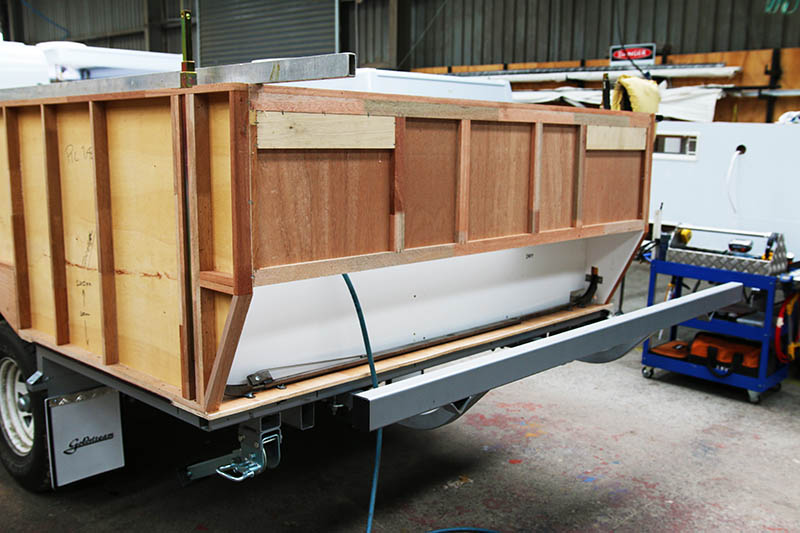 Kedron Caravans has always built its frames out of aluminium and its reputation has been cemented by its Gall Boys DVDs in which the Kedron team literally beat its caravans around the bush, dragging them through Cape York’s Gunshot or hammering along the Canning Stock Route. For Kedron, it’s aluminium all the way.
Kedron Caravans has always built its frames out of aluminium and its reputation has been cemented by its Gall Boys DVDs in which the Kedron team literally beat its caravans around the bush, dragging them through Cape York’s Gunshot or hammering along the Canning Stock Route. For Kedron, it’s aluminium all the way.
“With all of our experience, we set out to create and evolve the Kedron vans to be as strong as possible, and with this in mind chose a method of interlocking our aluminium frames that, once interlocked, are secured together with solid steel punch-pins – a machine shoots the steel pin through the interlocked frame, and flattens both sides, so as to eliminate the chance of, say, a pop-rivet from, well, popping,” Kedron’s Glen Gall said.
IN THE FRAME
The consensus is that a properly engineered aluminium caravan frame is well worth considering.
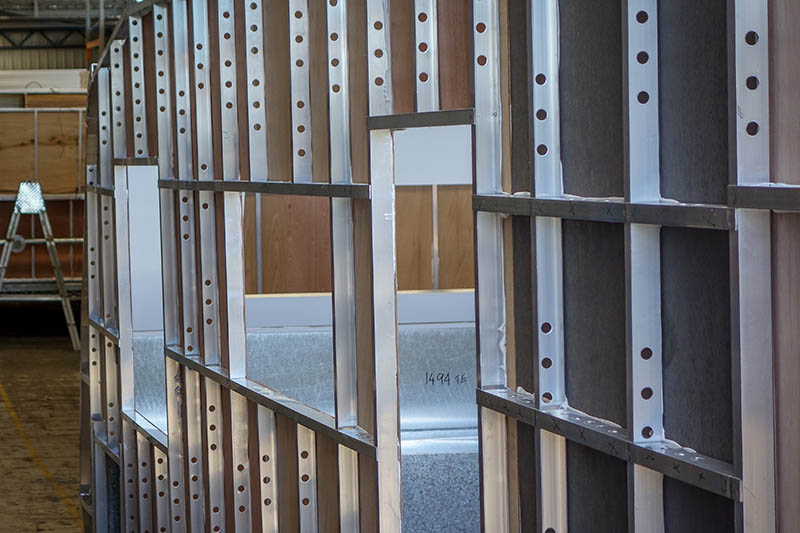 Shaun Noble, co-owner of Goldstream RV, agrees. Aluminium is light and durable. But to construct an aluminium caravan frame properly – in a way that will ensure the van outlasts the tow vehicle – takes more time, money and equipment. And therefore, from a cost perspective, the case for aluminium is not so cut and dried.
Shaun Noble, co-owner of Goldstream RV, agrees. Aluminium is light and durable. But to construct an aluminium caravan frame properly – in a way that will ensure the van outlasts the tow vehicle – takes more time, money and equipment. And therefore, from a cost perspective, the case for aluminium is not so cut and dried.
Goldstream builds its frames out of meranti timber. Not because Shaun necessarily believes it’s stronger but because he believes the main drawback – rot upon water ingress – can be avoided by proper sealing and therefore the additional costs to the manufacturer and customer can be avoided too.
He acknowledges, though, that all sealants have a shelf life. Eventually, to avoid water ingress, your van will need to be resealed. In Goldstream’s case, its vans are double-sealed, meaning sealant is applied behind the panels and again on the outside, under the J-mould (where some manufacturers would simply use foam tape).
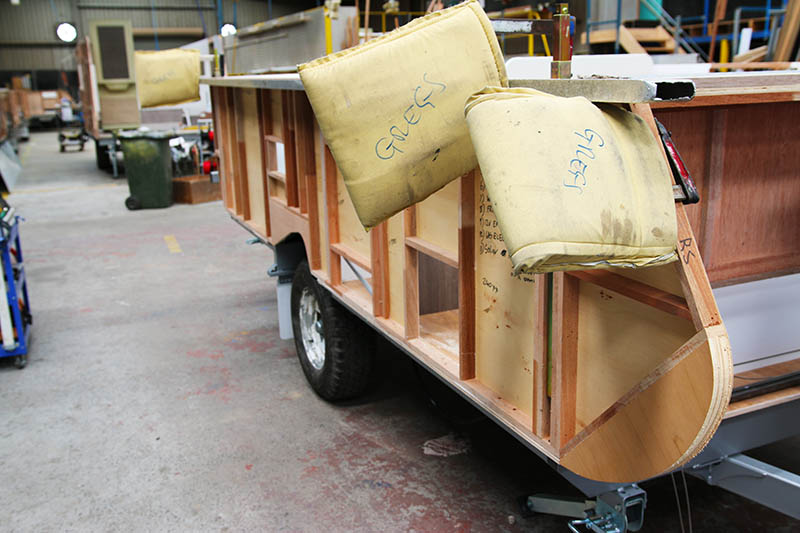 The matter of water ingress aside, timber is flexible, so it can adapt to the temperature and ‘move’ to a small degree depending on the terrain. It also gives a caravan manufacturer the ability to more readily accommodate changes requested by a customer.
The matter of water ingress aside, timber is flexible, so it can adapt to the temperature and ‘move’ to a small degree depending on the terrain. It also gives a caravan manufacturer the ability to more readily accommodate changes requested by a customer.
As Kedron’s Glen Gall says, “The drawbacks for our style of manufacturing would be the initial set-up cost of the factory equipment that’s required, such as the overhead rolling Henrob machines (special self-piercing riveting machines), alloy welders, the table and factory floor space required, the aluminium framing itself, the additional time required to create the frames, and not having the ability to simply place timber pieces and staple or screw them in place as you go.
“Our frames are all manufactured on tables, then stood and secured to the chassis. Grabbing the corners of the joined frames, the strength is incredible. The furniture is then fitted, as the aluminium frame is the solid base structure.”
OFFROAD MANUFACTURING
If it sounds like the case is well and truly made for timber, think again. There’s a reason why some of Australia’s most respected offroad van manufacturers build in aluminium. Kedron’s aluminium frames, once constructed, are placed into side Z-channel rails and ‘Huck-bolted’ down and sideways. A Huck bolt is one that, once a special collar is forcefully clamped onto the bolt’s thread, will never become unscrewed. Other manufacturers, such as Bushtracker and Sunland, use welded box-section aluminium.
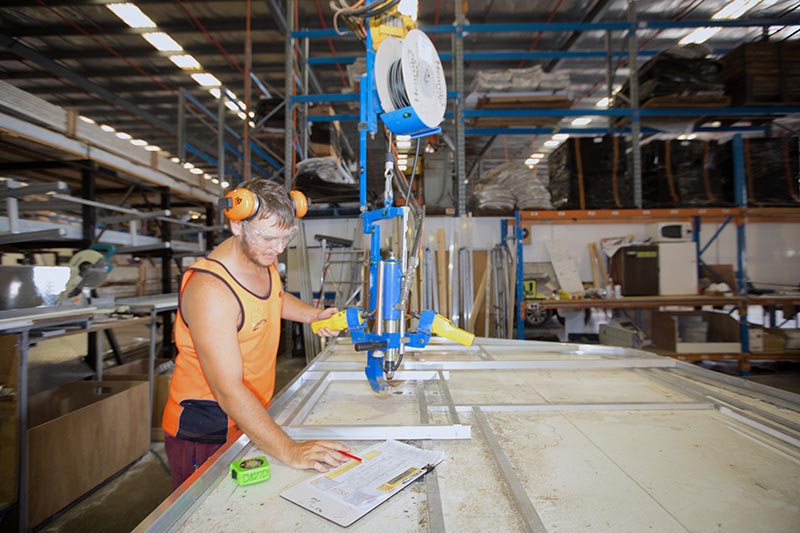 Ultimately, these frames should never fail under big loads and on extreme terrain. But doesn’t aluminium fatigue over time? Yes, it can. And in the same way that rotted timber is useless, fatigued aluminium has to be replaced.
Ultimately, these frames should never fail under big loads and on extreme terrain. But doesn’t aluminium fatigue over time? Yes, it can. And in the same way that rotted timber is useless, fatigued aluminium has to be replaced.
As far as Glen Gall is concerned, the ‘aluminium fatigue’ case is weak.
“This ‘argument’ is quickly settled if you look under the skin of, say, a 50-year-old Viscount and inspect the condition and maintained strength of its aluminium frame, whether or not the van had developed a leak over the years, in comparison to that of a van with a timber frame under the same time and conditions – the difference is light years apart!”
SUMMING UP
So where to from here? Should we all just trade in our vans for rigs built of fibreglass sandwich panels? No. But as you can see, there is, for the caravan purchaser, no easy answer. On the one hand, there’s no denying the strength and durability of a well-engineered aluminium frame, but on the other, timber-framed vans offer greater flexibility in terms of customisation and, with some exceptions, a lower price tag (though to be fair, there’s more behind a price tag than just the material used for the frame). And so long as the van remains properly sealed, a timber frame should last a very long time.
It is, therefore, perhaps wiser to take the whole van into consideration. The frame is an important aspect, no doubt, but where will you be taking it? What is your budget? Is that van you’ve fallen in love with built by an experienced, reputable manufacturer? These questions are, frankly, just as important.


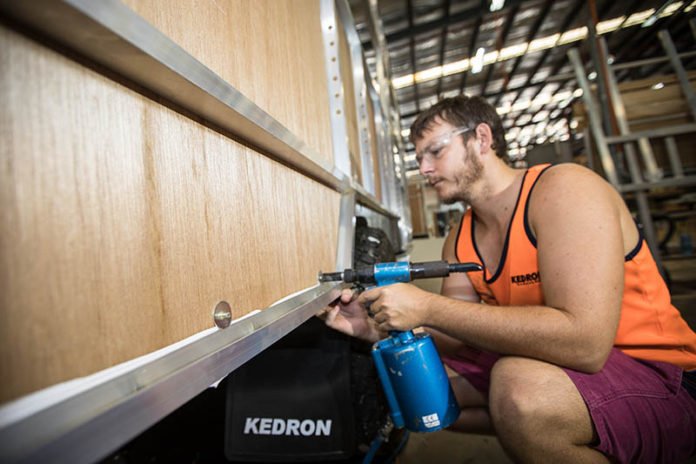
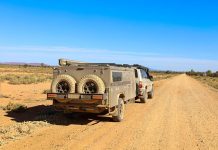

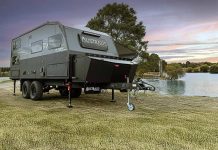

All enclosures are subject to water accumulation from condensation based on heating and cooling cycles. The size of air enclosure increases the amount of condensation retained each cycle. If meranti frame has solid foam insulation then it will create less moisture than loose wool type with air pockets.
I live in north QLD with humidity and had considerable water in the side walls of my caravan so the mercantile frame with glass wool insulation started to rot in the rear corners. My new van still has meranti frame but more solid insulation so I hope it lasts longer. Not all the water was from leakage as I had repainted and sealed the roof when the van was 3 yrs old but that did not decrease the wall moisture.
Note my Winch recently failed at 3 years on a new tow vehicle because it accumulated moisture in the motor and gear compartments when it had not been immersed or even used for recovery. The Winch had a cupful of accumulated moisture inside that caused the motor to fail.The logical cause was moisture accumulation from the cyclic breathing of a supposed sealed air space.
Same principle applies to wall spaces that are sealed. Better to vent and dry or eliminate the air volume or use aluminium.
FYI
Thanks Leo, you make some good points.
There is no comparison. I have owned caravans with wooden frames and aluminium frames. Water will find its way in no matter how much sealer is used. Miss one minute area with the sealer and water will get in. My wooden framed caravan had a small leak where the tail lights wire went through the skin. The wooden frame rotted out. I had to remove the skin from the rear and one side of the caravan to fix the frame. One of my aluminium framed caravans had a leak on the front window. The water rotted out a shelf in the cupboard. That was much easier to replace than the frame.
I had a Coromal aluminium framed caravan for 22 years. I never had any problems with the frame. That caravan went on some pretty rough roads throughout the Kimberley, Pilbara and South Australia. I now have a new Coromal. I hope that I get the same service from this one.
Aluminium frames vs Meranti timber frames on caravans.
Case in point:
My parents have a seaside holiday home set-up, which they have occupied for over 30 years. They have two caravans permanently on-site, both have had regular maintenance. One is a Meranti framed 28 footer, the other is a Aluminium framed 25 footer. Both vans were built by reputable manufacturers in the early 80’s. After sitting out in the marine environment for 30 years, the Aluminium framed caravan is in much better shape: importantly it’s roof is still the shape it was when built, on the other hand, the Meranti framed caravan has suffered, it’s roof has sagged considerably – to the point that water was pooling on it and causing the roof-vents to leak. Over just one winter when unoccupied, this caused rot and serious damage to the ceiling. To remedy the problem, the Meranti-framed caravan has had a Colourbond-type roof built over it, as repairing it’s framing and resealing the roof properly on site would have been very, very difficult. The Aluminium-framed caravan, on the other hand, is still sound, and would still be road worthy.
And just to push the point home; there is a large solid-walled annex bolted to the timber-framed caravan. This annex sits above ground on piles; there is a decent air-gap underneath. The annex has aluminium framed modular panels and an aluminium exterior skin, and originally had plywood timber lining over 50mm thick styrofoam insulation. It sits on a heavy treated timber beam framed floor and is covered by a laminated timber framed colourbond-type pitched steel roof, which is lined and insulated. The aluminium in the annex is in very good condition, but almost all of the plywood interior lining rotted within 10 years of being on this site, and has since been replaced by plastic composite sheeting. The heavy timber framing under the floor has also developed rot in the beams, and we face the job of dismantling and replacing the floor framing. We will be using galvanised steel channel this time, and the aluminium walls will sit on 3mm thick nylon sheet to eliminate the possibilty of galvanic corrosion. Gotta love that salty air.
I think this proves that most timber cannot survive long exposure to salty humid air, unless it is constantly kept oiled or varnished. This is not possible when it cannot be reached.
Aluminium frames might be more expensive to manufacture, but a caravan needs to stand up to the use it will be subjected to. I don’t see, from the evidence here, that there is a strong case for timber frames.
Interesting….
Thanks for your comment, Shane. You’ve given an interesting insight.